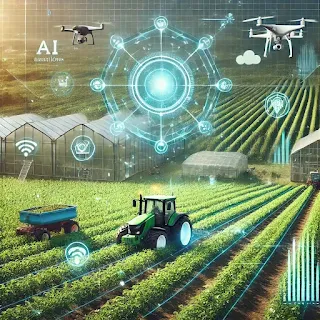What You Think: How AI Is Helping Agriculture for Growth
Agriculture is the backbone of human civilization, providing food, raw materials, and employment for billions worldwide. However, with growing populations, climate change, and resource constraints, traditional farming methods struggle to meet demand. This is where Artificial Intelligence (AI) in agriculture is making a transformative impact, helping farmers increase efficiency, improve yield, and sustain long-term growth.
In this blog, we will explore how AI is helping agriculture grow, the latest AI applications, and how it is shaping the future of farming.
The Role of AI in Agriculture Growth
AI is revolutionizing agriculture by automating processes, providing real-time data insights, and improving decision-making. Here are some key ways AI contributes to agricultural growth:
1. Precision Farming
Precision farming, powered by AI, allows farmers to optimize crop management with real-time data analysis. AI-driven sensors, drones, and satellite imagery help monitor soil health, water levels, and crop conditions. This data enables farmers to make informed decisions about irrigation, fertilization, and harvesting, resulting in increased efficiency and higher yields.
2. AI-Powered Crop Monitoring and Disease Detection
AI-driven computer vision and machine learning algorithms can detect early signs of crop diseases, pests, and nutrient deficiencies. AI-powered tools like Plantix, PEAT, and Agrio use image recognition to analyze plant health and provide actionable recommendations. This helps farmers take preventive measures, reducing crop loss and ensuring a higher-quality yield.
3. Automated Irrigation Systems
Water management is critical for sustainable agriculture. AI-based irrigation systems analyze weather patterns, soil moisture, and crop requirements to optimize water usage. AI-powered irrigation platforms like AquaSpy and NetBeat help farmers save water, reduce costs, and improve crop growth by ensuring optimal hydration.
4. AI in Pest Control and Weed Management
AI-powered drones and robots can detect and eliminate pests and weeds with precision. AI-based systems such as Blue River Technology’s See & Spray use computer vision to differentiate between crops and weeds, applying herbicides only where needed. This minimizes chemical use, reduces environmental impact, and saves costs for farmers.
5. AI-Powered Robotics for Harvesting
Labor shortages are a major challenge in agriculture, but AI-driven robots are stepping in to fill the gap. Harvesting robots like Agrobot, FFRobotics, and Abundant Robotics use AI to identify ripe fruits and vegetables, picking them efficiently without damaging the crops. This reduces reliance on manual labor and speeds up the harvesting process.
6. AI-Driven Market Forecasting and Supply Chain Optimization
AI analyzes market trends, weather conditions, and consumer demand to help farmers make better business decisions. AI-based predictive analytics tools provide insights into pricing, crop demand, and distribution logistics. This allows farmers to plan ahead, reduce waste, and maximize profits.
Real-World Examples of AI in Agriculture
AI’s impact on agriculture is already evident in various successful implementations worldwide. Here are some real-world examples:
John Deere’s AI Tractors: John Deere uses AI-powered autonomous tractors equipped with sensors and GPS to perform tasks like plowing and planting with precision.
IBM Watson Decision Platform for Agriculture: This AI-driven platform provides predictive insights based on weather, soil health, and crop conditions, helping farmers improve productivity.
Microsoft’s AI for Earth Initiative: Microsoft collaborates with farmers to develop AI-powered solutions that enhance sustainability and increase yield.
AI-Powered Smart Greenhouses: AI-driven climate control systems optimize temperature, humidity, and light in greenhouses, leading to better crop growth.
The Future of AI in Agriculture
The future of AI in agriculture looks promising, with continuous advancements expected in the following areas:
More Efficient AI-Powered Drones: Drones with AI capabilities will continue to improve in monitoring fields, analyzing soil conditions, and automating crop spraying.
AI-Powered Soil Health Monitoring: AI will play a bigger role in soil testing, detecting nutrient levels, and recommending customized fertilizers.
Blockchain and AI Integration: Combining AI with blockchain technology will improve supply chain transparency and traceability in agriculture.
AI-Powered Vertical Farming: AI will enhance indoor farming techniques, maximizing space efficiency and increasing food production in urban areas.
Conclusion
AI is playing a transformative role in agriculture, helping farmers increase productivity, reduce costs, and promote sustainable farming practices. From precision farming and pest control to AI-powered robotics and predictive analytics, AI is shaping the future of agriculture and ensuring global food security.
As AI technology continues to evolve, its applications in agriculture will only expand, making farming smarter, more efficient, and more profitable. Farmers, agribusinesses, and policymakers must embrace these advancements to drive agricultural growth and sustainability.
What do you think about AI’s impact on agriculture? Share your thoughts in the comments!




Comments
Post a Comment